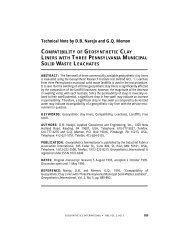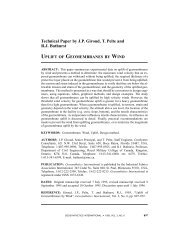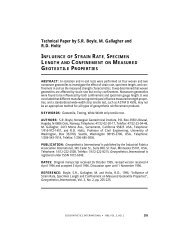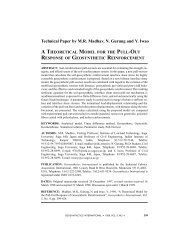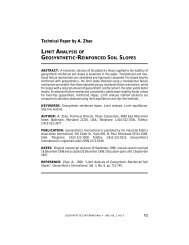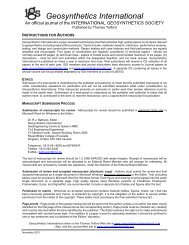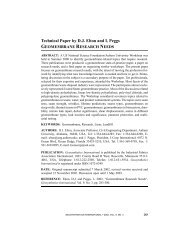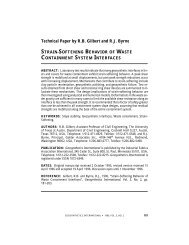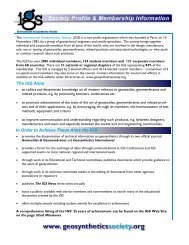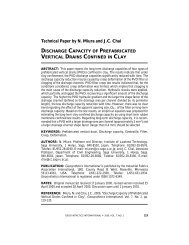Technical Paper by JP Giroud, KL Soderman and K. Badu-Tweneboah
Technical Paper by JP Giroud, KL Soderman and K. Badu-Tweneboah
Technical Paper by JP Giroud, KL Soderman and K. Badu-Tweneboah
You also want an ePaper? Increase the reach of your titles
YUMPU automatically turns print PDFs into web optimized ePapers that Google loves.
GIROUD et al. D Optimal Configuration of a Double Liner System<br />
1 INTRODUCTION<br />
In many l<strong>and</strong>fills <strong>and</strong> other waste containment systems where a double liner system<br />
is used, the primary liner is a geomembrane <strong>and</strong> the secondary liner is a composite liner<br />
that consists of a geomembrane on a layer of compacted clay (Figure 1a). The inverse<br />
configuration where the geomembrane-compacted clay composite liner is the primary<br />
liner <strong>and</strong> the geomembrane used alone is the secondary liner (Figure 1b) is rarely considered<br />
because: (i) compaction of the clay could damage the geomembrane used as the<br />
secondary liner (<strong>and</strong> the geonet, if one is used in the secondary leachate collection layer);<br />
<strong>and</strong> (ii) regulations often prescribe the first configuration.<br />
Geosynthetic clay liners (GCLs) are increasingly used instead of compacted clay in<br />
composite liners. GCLs are usually installed with light equipment that should not damage<br />
the underlying geosynthetics. Therefore, when a GCL is used, both configurations<br />
can be considered: (i) the geomembrane alone as the primary liner <strong>and</strong> the geomembrane-GCL<br />
composite liner as the secondary liner (Figure 1c); <strong>and</strong> (ii) the inverse configuration<br />
(Figure 1d). A comparison between these two configurations is presented in<br />
this paper.<br />
It is realized that several criteria <strong>and</strong> approaches can be used to compare liner systems.<br />
However, only leachate migration due to advective flow of leachate through geomembrane<br />
defects is considered herein. The considered defects are defects in the geomembrane<br />
used alone as well as defects in the geomembrane component of the<br />
composite liner.<br />
The purpose of the comparison presented herein is to provide information that may<br />
be used as part of the process for selecting the optimal configuration for a double liner<br />
system.<br />
2 METHODOLOGY<br />
2.1 Approach<br />
The two double liner systems considered in the study are shown in Figure 2. For each<br />
of the two liner systems, the rate of leachate migration through the secondary liner is<br />
calculated according to the following four steps:<br />
S A given average head of leachate on top of the primary liner is considered.<br />
S The rate of leachate migration through the primary liner due to advective flow<br />
through defects in the primary liner geomembrane is calculated.<br />
S The average head of leachate on top of the secondary liner due to leachate that has<br />
migrated through the primary liner is calculated.<br />
S The rate of leachate migration through the secondary liner due to advective flow<br />
through defects in the secondary liner geomembrane is calculated.<br />
The rate of leachate migration through the secondary liner thus calculated is the rate<br />
of leachate migration into the ground.<br />
It is preferable to discuss leachate head calculation prior to discussing leachate migration<br />
calculations due to numerous references to leachate head in leachate migration cal-<br />
374 GEOSYNTHETICS INTERNATIONAL S 1997, VOL. 4, NOS. 3-4



